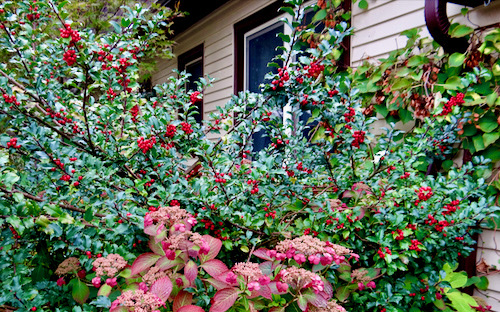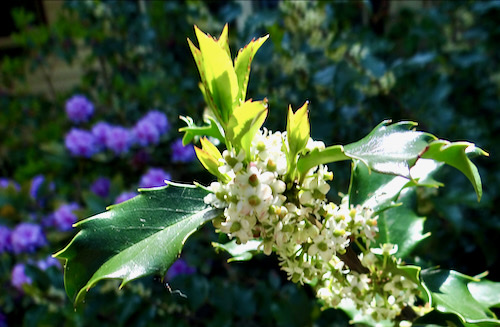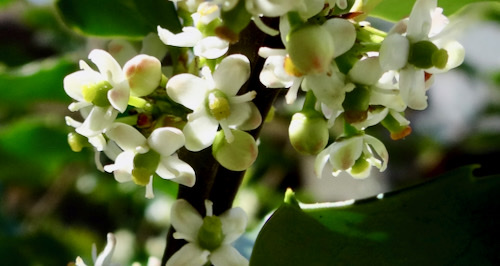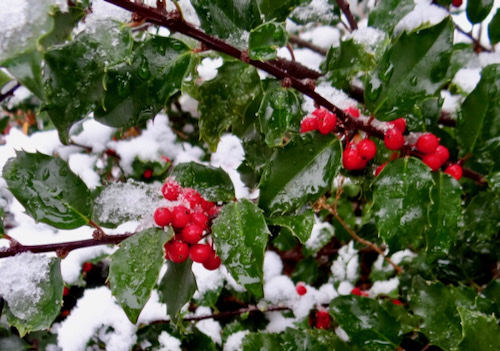
Plant of the Month November 2022
GENERAL INFORMATION:
Holly berries were an important part of our winter decorations in England when I was young. We checked all the holly trees on the farm in October for the best potential crop. We took a sled to collect branches just before Christmas, hoping for some ice or snow. Some vigorous trees never had berries. I eventually learned these were male.
English holly, Ilex aquifolium, is not hardy in Toronto. However, I found the Merserveae Hollies. Kathleen K. Meserve crossed Ilex aquifolium (English Holly, hardy to Zone 7) with I. rugosa (Tsuru Holly, hardy to Zone 3) in the 1950s. A patent for ‘Blue Princess’ was issued in 1975. I now grow several plants.
Common Name: Blue Holly

Ilex x meserveae 'Blue Princess'.
Cultivars: Ilex × meserveae ‘Blue Prince’, 'Blue Boy' & 'Blue Girl’, 'Blue Stallion' & 'Blue Maid’, 'China Girl’ & ‘China Boy’ (green foliage), ‘Castle Spire’ & ‘Castle Wall’ (narrow), ‘Little Rascal’ & ’Scallywag’ both male, 0.7 m high, both will pollinate other hollies. Many hollies have patent names.
Life Cycle: Broad-leaved evergreen shrub.
Height: 3-5 m.
Bloom Time: April, May.
Flower Colour & Size: Flowers on old wood. Small (3 mm) clusters of scented, white, 4-petalled flowers, with male and female on separate plants (dioecious). (Male have stamens, females have stamens without pollen bearing anthers.)

Ilex x meserveae 'Blue Princess' female flowers.

Close up of female flowers without anthers.
Fruit: Glossy bright red, 6 cm berries, from September through winter, or until eaten by birds.

Ilex x meserveae 'Blue Princess' berries in early winter.
Leaves: Shiny, blue-green 7 cm oval leaves with wavy margins and prominent spines, growing from purple stems.
Habitat: Garden hybrid.
Environmental Use: Pollen and nectar in spring. Fall and winter food for birds. Year round shelter.
CULTIVATION:
Plant: A male plant is necessary for pollination and berry formation. One male shrub is enough to pollinate five female shrubs of the same group if planted in proximity.
Light: Sun to part shade.
Soil: Neutral to slightly acidic.
Water: Average, moist well drained soil.
USDA Hardiness: Zone 4.
Planting: Use as a hedge, a specimen or in a mixed shrub border with more neutral soil tolerant rhododendrons such as ‘P.J.M.’
Pruning: As necessary, after the flowers form. Also a careful early December pruning for decorative branches indoors or in planters.
Propagation: Hybrid, so seed will not breed true. Also very slow germination. Check if Plant Protected. Take softwood cuttings in the late spring and early summer.
Problems: Usually problem free but may need protection from winter sun scorch. Leaf miner, scale, powdery mildew can occur.
References:
https://www.missouribotanicalgarden.org/PlantFinder
https://web.extension.illinois.edu/shrubselector
Text and images supplied by Anna Leggatt
